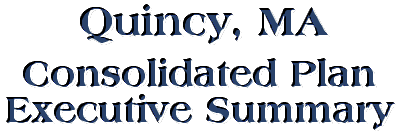

Quincy's 1995 Consolidated Plan constitutes a strategic vision for housing and community development for the city. This document summarizes the plan so that citizens in the community can have a quick overview of the housing and community development problems; the 5 year broad objectives and actions proposed to meet those goals; and specific projects for carrying out this strategy during 1995.
The Consolidated Plan includes a 1-year action plan for 66 projects, spending approximately $2.600 million in Community Development Block Grant (CDBG) funds in 1995. Those funds will be spent on Non-Profit Public Facilities, Public Works, Economic Development, Code Enforcement, Handicapped Accessibility, Non-residential Historic Preservation, Public Services, and Planning.
The City of Quincy adopted a citizen participation plan aimed at encouraging
and inviting local citizen participation, particularly low-and moderate income
persons, minorities, and non-English speaking residents. The City held several
public hearings to obtain citizen's views, opinion on community development and
housing needs, proposal for potential activities and projects. and comments on
review of program performance. Copies of the proposed consolidated plan were
made available on request from the PCD office, Thomas Crane Public library main
Branch, and at the Office of Housing Rehabilitation. The city also published a
summary of the proposed plan in two local newspapers of general circulation.
The City of Quincy, MA is an urban community located in Eastern MA. It is bordered by the Town of Milton on the West, the City of Boston on the northwest, the Atlantic Ocean on the north and east, and the Towns of Weymouth , Braintree and Randolph on the south.
The City of Quincy's census indicates the total population has grown to 87,171 in 1994. The racial distribution in Quincy has changed dramatically between 1980 and 1990 with the influx of Asian, Black, and Hispanic people. The 1990 census indicates that non-white population constitutes 8.1% of the total population of the City. As of 1994 it is estimated that the minority population has grown to 15% of the City total.
In 1990, nearly 28,000, or close to 34% of Quincy's population, had income
below 80% of the median income in the Boston metropolitan area. Quincy's median
income, per 1990 Census, was $35,858 for households, $44,184 for families and
$23,907 for non-family households. The median family income for the Boston SMSA
was 11% higher than Quincy's. In 1990, 5707 persons, representing 6.8% of total
population in Quincy, had income below the poverty line. Of this, 87.9% were
white, 12.1% were from different minority groups. In terms of families, 7.3% of
Quincy's total number of families, had incomes below the poverty line.
The 1990 Census Statistics indicate that Quincy's total population was 84,985, a very slight increase from 84,743 recorded in 1980. Because of a high ratio of elderly people Quincy's median age was 34.7 years in 1990 compared to 31.1 years in 1970. As of 1990, Quincy had 2.34 persons per household and 3.07 persons per family.
In 1990, there were 60,419 persons 25 years of age or older, 11.7% did not complete high school, and 5.5% did not reach high school. Also in 1990 there were 72,176 persons 16 years and older. Of this 69.5% were in the labor force. Unemployment in February 1995 was at 6%.
The development of plans and studies will continue to be important for the City of Quincy. Various housing, economic and community development issues will have to be analyzed and appropriate strategies, programs, policies, and projects developed or formatted. The City is currently working with the Quincy 2000 Corporation in conducting some of the planning studies and initiatives needed to expand economic opportunities. For example, Quincy 2000 is currently involved with the development of the Quincy Center downtown area and is conducting a Quincy Center Development Plan. A Tourism Development Plan is also being conducted through the Mayor's office, Quincy 2000, and the Quincy Tourism and Visitor Bureau.
Studies are also needed in the areas of traffic and transportation. Such studies are needed to aid in the revitalization efforts and the creation of jobs in the commercial areas throughout the City. Wollaston, North Quincy, and the Quincy Center downtown area provide specific examples where research and feasibility studies are necessary to help revitalize the commercial areas in the City. The Quincy Shipyard site also represents a site where studies, such as site review and feasibility studies are needed. There is an on-going need for the City to collect and maintain statistical data to support program and business needs throughout the City.
Public facilities, infrastructure improvements, public services, economic
development, tourism, historic preservation and planning are important to
providing long-term improvements in the lives of low-income residents of Quincy.
The primary nonhousing community development need of the city is to construct,
renovate, or repair non-profit public facilities that provide invaluagle
services to the City. Several non-profit public facilities that provide
invaluable services to low and moderate income people need to be renovated,
reconstructed, or repaired to meet the needs of their program beneficiaries or
to eliminate code violations. The CDBG program has been an important resource
which together with other funds have been used and will continue to be used for
public facilities and improvements in low-mod income areas, as well as slum and
blighted areas.
This Non-Housing Community Development Strategic Plan is a five (5) year plan that seeks to achieve the following, principally for low, very low and extremely low income residents: provide decent housing and suitable living environment and expand economic opportunities.
The action plan describes the proposed uses of the $2,639,000 that the City will receive from the U.S. Department of Housing and Urban Development (HUD) for the Community Development Block Grant (CDBG) program.
MAP 2 depicts points of interest and low-moderate income areas.
MAP 3 depicts points of interest, low-moderate income areas, and minority concentration levels.
MAP 4 depicts points of interest, low-moderate income areas, and unemployment levels.
MAP 5 depicts points of interest, low-moderate income areas, unemployment levels, and proposed HUD funded projects.